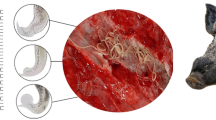Abstract
The objective of the present study was to examine the phylogenetic position of Setaria cervi based on sequences of mitochondrial cytochrome c oxidase subunit 1 (cox1) gene. A fragment of the cox1 gene from two morphologically identified S. cervi collected from red deer (Cervus elaphus) from Italy were amplified, sequenced, and compared with corresponding sequences of other filarioid nematode species. Phylogenetic studies using Bayesian analysis revealed S. cervi as monophyletic with other Setaria species, confirming S. cervi as a member of the Setaria genus. S. cervi appeared to be sister species to Setaria labiatopapillosa and Setaria digitata. Setaria tundra and Setaria equina, the other two Setaria species presented in the Italian fauna, formed a sister group to the clade consisting of S. cervi, S. labiatopapillosa, and S. digitata. In addition to phylogenetic clarification, our study is the first molecular identification of S. cervi, which may be useful for further molecular identification and differentiation of this filarial worm from other filarioid nematode species, especially in the earlier developmental stages of its life cycle.

Similar content being viewed by others
References
Almeida AJ, Deobhankar KP, Bhopale MK, Zaman V, Renapurkar DM (1991) Scanning electron microscopy of Setaria cervi adult male worms. Int J Parasitol 21:119–121
Anderson RC (2000) The superfamily Filaroidea. In nematode parasites of vertebrates. Their development and transmission, 2nd edn. CABI Publishing, New York, pp 467–529
Bain O (2002) Evolutionary relationships among filarial nematodes. In: Chabaud AG, Bain O (eds), 1976. La lignée Dipetalonema. Nouvel essai de classification. Ann Parasitol Hum Comp 51:365–397
Becklund WW, Walker ML (1969) Taxonomy, hosts, and geographic distribution of the setaria (Nematoda: Filarioidea) in the United States and Canada. J Parasitol 55:359–368
Böhm LK, Supperer R (1955) Untersuchungen űber Setarien (Nematode) bei heimischen Wiederkäuern und deren Beziehung zur epizootischen cerebrospinalen Nematodiasis (Setariosis). Parasitol Res 17:165–174
Cancrini G, Kramer LH (2001) Insect vectors of Dirofilaria spp. In: Simon F, Genchi C (eds) Heartworm infection in humans and animals. Universidad de Salamanca, Spain, pp 63–82
Casiraghi M, Anderson TJC, Bandi C, Bazzocchi C, Genchi C (2001) A phylogenetic analysis of filarial nematodes: comparison with the phylogeny of Wolbachia endosymbionts. Parasitology 122:93–103
Chabaud AG, Bain O (1994) The evolutionary expansion of the Spirurida. Int J Parasitol 24:1179–1201
Favia G, Lanfrancotti A, Della Torre A, Cancrini G, Coluzzi M (1997) Advances in the identification of Dirofilaria repens and Dirofilaria immitis by a PCR-based approach. Parassitologia 39:401–402
Favia G, Cancrini G, Ferroglio E, Casiraghi M, Ricci I, Rossi L (2003) Molecular assay for the identification of Setaria tundra. Vet Parasitol 117:139–145
Genchi C, Rinaldi L, Mortarino M, Genchi M, Cringoli G (2009) Climate and Dirofilaria infection in Europe. Vet Parasitol 163:286–292
Giannetto S, Zanghi A, Cristarella (1996) Observations of Setaria equina (Nematoda: Setariidae) with the optical microscope and scanning electron microscope. Parassitologia 38:525–529
Gouy M, Guindon S, Gascuel O (2010) SeaView version 4: a multiplatform graphical user interface for sequence alignment and phylogenetic tree building. Mol Biol Evol 27:221–224
Huelsenbeck JP, Ronquist FR (2001) Mrbayes: Bayesian inference of phylogenetic trees. Bioinformatics 17:754–755
Laaksonen S, Pusenius J, Kumpula J, Venäläinen A, Kortet R, Oksanen A, Hoberg E (2010) Climate change promotes the emergence of serious disease outbreaks of filarioid nematodes. EcoHealth 7:7–13
Larkin MA, Blackshields G, Brown NP, Chenna R, McGettigan PA, McWilliam H, Valentin F, Wallace IM, Wilm A, Lopez R, Thompson JD, Gibson TJ, Higgins DG (2007) Clustal W and Clustal X version 2.0. Bioinformatics 23:2947–2948
Madathiparambil MG, Kaleysa KN, Raghavan K (2009) A diagnostically useful 200-kDa protein is secreted through the surface pores of the filarial parasite Setaria digitata. Parasitol Res 105:1099–1104
Manfredi MT, Piccolo G, Fraquelli C, Perco F (2003) Elmintofauna del cervo nel Parco Nazionale dello Stelvio. J Mt Ecol 7:245–249
Nayak A, Gayen P, Saini P, Maitra S, Sinha Babu SP (2011) Albendazole induces apoptosis in adults and microfilariae of Setaria cervi. Exp Parasitol 128:236–242
Pietrobelli M, Frangipane di Regalbono A, Segato L, Tampieri MP (1995) Bovine setariasis in Friuli Venezia Giulia. Parassitologia 37:69–74
Posada D (2008) jModelTest: phylogenetic model averaging. Mol Biol Evol 25:1253–1256
Sambrook J, Fritsch EF, Maniatis T (1989) Molecular cloning: a laboratory manual, 2nd edn. Cold Spring Harbor Laboratory, Cold Spring Harbor
Shoho C (1967) Zur Systematik der Setaria-Arten (Filarioidea, Nematoda) von Rothhirsch und Maral. Zool Anz 183:298–308
Shoho C, Uni SK (1977) Scanning electron microscopy (SEM) of some Setaria species (Filaroidea, Nematoda). Parasitol Res 53:93–104
Singhal KC, Chandra OM, Saxena PN (1972) An in vitro method for the screening of antifilarial agents using Setaria cervi as test organism. Jpn J Pharmacol 22:175–179
Srinivasan L, Mathew N, Muthuswamy K (2009) In vitro antifilarial activity of glutathione S-transferase inhibitors. Parasitol Res 105:1179–1182
Swofford D (2002) PAUP*: phylogenetic analysis using parsimony (*and other methods), version 4. Sinauer Associates, Sunderland
Urquhart GM, Armour J, Duncan JL, Dunn AM, Jennings FW (1996) Veterinary parasitology, 2nd edn. Blackwell Science Ltd, Oxford
World Health Organization (2007) Global programme to eliminate lymphatic filariasis: annual report on lymphatic filariasis 2006. Wkly Epidemiol Record 82:361–380
Yatawara L, Wickramasinghe S, Nagataki M, Rajapakse RPVJ, Agatsuma T (2007) Molecular characterization and phylogenetic analysis of Setaria digitata of Sri Lanka based on CO1 and 12S rDNA genes. Vet Parasitol 148:161–165
Acknowledgments
The research was supported by RNM-6400, Projecto de Excelencia (Junta de Andalucia, Spain). XQZ is supported by the State Key Laboratory of Veterinary Etiological Biology, Lanzhou Veterinary Research Institute, Chinese Academy of Agricultural Sciences (Grant Nos. SKLVEB2009KFKT014 and SKLVEB2010KFKT010), and the Yunnan Provincial Program for Introducing High-level Scientists (Grant No. 2009CI125). The experiments comply with the current laws of the country in which the experiments were performed.
Author information
Authors and Affiliations
Corresponding author
Rights and permissions
About this article
Cite this article
Alasaad, S., Pascucci, I., Jowers, M.J. et al. Phylogenetic study of Setaria cervi based on mitochondrial cox1 gene sequences. Parasitol Res 110, 281–285 (2012). https://doi.org/10.1007/s00436-011-2486-1
Received:
Accepted:
Published:
Issue Date:
DOI: https://doi.org/10.1007/s00436-011-2486-1




